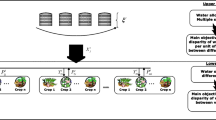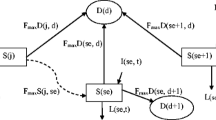Abstract
The escalating world population has led to a drastic increase in water demand in the municipal and drinking water, agriculture and industry sectors. This situation necessitates application of effective measures for the optimal and efficient management of water resources. With this respect, a two-objective socioeconomic model (aimed at job creation) has been presented in this study for the optimum allocation of water resources to industry, agriculture and municipal water sectors. In the agriculture sector, the production function of each product has been determined and then, based on the production functions, areas under cultivation, product yield and the income obtained from each product, the combined objective function has been specified. In the industry sector, since water demand is a function of the amount of produced products, price of supplied water and the price of other supplies, the demand function of this sector was determined regionally. Also, considering the existing necessity in meeting the municipal water requirement, the total amount of water needed by this sector was fully allocated. Then by using two meta-heuristic algorithms, i.e. genetic algorithm (GA) and particle swarm optimization (PSO), the objective functions were maximized and the water resources were optimally allocated between agriculture and industry sectors and the results were compared. Ultimately, comparing the results gained by PSO and GA algorithms, PSO with an economic and profit growth of 54 % and a 13 % rise in employment relative to the base condition, turned out to be more efficient in this application.



Similar content being viewed by others
Notes
e 4E − 08D = e 0.000000004D
e 4E − 08D = e 0.000000004D
References
Abrishamchi A, Ebrahimian A, Tajrishi M (2005) Case study: application of multicriteria decision making to urban water supply. J Water Resour Plan Manag 131(4):326–335
Alba E, Troya JM (2002) Improving flexibility and efficiency by adding parallelism to genetic algorithms. Stat Comput 12(2):91–114
Babel MS, Das Gupta A, Nayak DK (2005) A Model for Optimal Allocation of Waterto Competing Demands. Water Resour Manag 19:693–712. doi:10.1007/s11269-005-3282-4
Benli B, Kodal S (2003) A non-linear model for farm optimization with adequate and limited water supplies application to the south-east Anatolian project (GAP) region. Agric Water Manag 62:187–203
Bielsa J, Duarte R (2001) ‘An economic model for water allocation in North Eastern Spain’, Water Res. Dev 17(3):397–410
Blackwell, T. and J. Branke. (2004). Multi-swarm optimization in dynamic environments. In G. R. Raidl, S. Cagnoni, J. Branke, D. Corne, R. Drechsler, Y. Jin, C. G. Johnson, P. Machado, E. Marchiori, F. Rothlauf, G. D. Smith, and G. Squillero, eds., Proceed- ings of Applications of Evolutionary Computing: EvoBIO, EvoCOMNET, EvoHOT, EvoIASP, EvoMUSART, and EvoSTOC (EvoWorkshops’04), vol. 3005 of Lecture Notes in Computer Science. Springer-Verlag, New York, pp. 489–500
Branke J, Kaufler T, Schmidt C, Schmeck H (2000) A multipopulation approach to dynamic optimization problems. In: In I. C. Parmee, ed., proceedings of the 4th international conference on adaptive computing in design and manufacture (ACDM’00), university of Plymouth, Devon, UK., springer-verlag, New York, pp. 299–308
Cai X, McKinney DC, Lasdon LS (2003) Integrated hydrologic-agronomic-economic model for river basin management". ASCE J Water Resour Plan Manag 129(1):4–17
Cheng KCK, Yap RHC (2006) Applying ad-hoc global constraints with the case constraint to still-life. Constraints 11:91–114
Cotta, C. and A. J. Fernandez. (2004). A hybrid GRASP: evolutionary algorithm approach to Golomb ruler search. In Xin Yao et al., eds., Parallel Problem Solving from Nature VIII, vol. 3242 of Lecture Notes in Computer Science. Springer-Verlag, New York, pp. 481–490.
Divakar L, Babel MS, Perret SR, Das Gupta A (2011) Optimal allocation of bulk water supplies to competing use sectors based on economic criterion – an application to the Chao Phraya river basin, Thailand. J Hydrol 401:22–35. doi:10.1016/j.jhydrol.2011.02.003
Doorenbos, J. and Kassam, A. H. (1977). Yield response to water, irrigation and drainage, paper 33, food and agricultural organization of the united nations, Rome, Italy, 39.
Doorenbos J, Pruitt WO (1984) Guidelines for predicting crop water requirements, irrigation and drainage, paper 24. Food and Agricultural Organization of the United Nations, Rome, Italy, pp. 35–48
Doreo J, Siarry E, Petrowski A, Taillard E (2006) Metaheuristic for hard optimization. Springer-Verlag 12-30
Fan, T., Stewart, B. A., Payne, W. A, Wang, Y, Song, S., Luo, J. and Robinson, CA. (2005). Supplemental irrigation and water: yield relationship for plasticulture crops in the loess plateau of China. Agron J, 97: 177–188.
García-Vila M, Fereres E (2012) Combining the simulation crop model AquaCrop with an economic model for the optimization of irrigation management at farm level. Eur J Agron 36:21–31
Glodberg DD (1989) Genetic algorithms in search, optimization, and machine learning. Addison Wesley Publ com Inc 401
Han Y, Xu SG, Xu XZ (2008) Modeling multisource multiuser water resources allocation. Water Resour Manag 22(7):911–923
Harou J, Pulido-Velazquez M, Rosenberg DE (2009) Medellín-azuara J., Lund J.R., howitt R.E. Hydro-economic models: concepts, design, applications, and future prospects. J Hydrol 375:627–643. doi:10.1016/j.jhydrol.2009.06.037
Howley T, Madden MG (2005) The genetic kernel support vector machine: description and evaluation. Artif Intell Rev 24(3–4):379–395
Jalal M (2015) Soft computing Techniques for Compressive strength Prediction of Concrete cylinders Strengthened by CFRP Composites. Sci Eng Compos Mater 22(1):97–112
Karamouz M, Szidarovszky F, Zahraie B (2003) Water resources systems analysis. Lewis Publishers, P 30-48
Kennedy J, Eberhart RC (2001) Swarm intelligence. Morgan Kaufmann, San Francisco, CA
Kijne JW, Barker R, Molden DJ (2003) Water productivity in agriculture: limits and opportunities for improvement. CABI, IWMI, Wallingford, UK
Kirda C (2005) Deficit irrigation scheduling based on plant growth stages showing water stress tolerance, natural resources management and environment department. Cukuroya University, Adana, Turkey
Li YP, Huang GH, Nie SL (2006) An interval-parameter multi-stage stochastic programming model for water resources management under uncertainty. Adv Water Resour 29:776–789
Loucks DP (2000) Sustainable water resources management. Water Int 25(1):3–10
Loucks DP, van beek E (2005) Water resources systems planning and management: an introduction to methods, models and applications", 1st edn. UNESCO
McKinney DC, Cai X (2002) ‘Multiobjective optimization model for water allocation in the Aral sea basin: stochastic optimization’, draft working paper, environmental and water resources engineering program. University of Texas at Austin, Austin, Texas
Medellín-Azuara J, Lund JR, Howitt R (2007) Water supply analysis for restoring the Colorado river delta, Mexico. J Water Resour Plan Manag 133(5):462–471
Mendoza GA, Bare BB, Zhou Z (1993) A fuzzy multiple objective linear programming approach to forest planning under uncertainty. Agric Syst 41:257–274
Mitchell M (1996) An introduction to genetic algorithms. MIT Press, Cambridge, MA, pp. 55–65
Moscato P, Cotta C (2003) A gentle introduction to memetic algorithms. In: Glover F, Kochenberger G (eds) Handbook of metaheuristics. Kluwer Aca- demic, Norwell, MA, pp. 105–144
Newlin BD, Jenkins MW, Lund JR, Howitt RE (2002) Southern California water markets: potential and limitations. J Water Resour Plan Manag – ASCE 128(1):21–32
Panda RK, Behera SK, Kashyap PS (2003) Effective management of irrigation water for wheat under stressed conditions. Agric Water Manag 63(1):37–56
Quanqi L, Xunbo Z, Yuhai C, Songlie Y (2012) Water consumption characteristics of winter wheat grown using different planting patterns and deficit irrigation regime. Agric Water Manag 105:8–12
Rao, S. S. (1984). Optimization theory and application, Second Edition, Altalsted Press Book, John Wilry and Sons, 1247.
Rasmussen TK, Krink T (2003) Improved hidden Markov model training for multiple sequence alignment by a particle swarm optimization–evolutionary algorithm hybrid. Biosystems 72(1–2):5–17
Reca J, Roldan J, Alcaide M, Camacho E (2001) Optimization model for water allocation in deficit irrigation system: I. Description of the model. Agric Water Manag 48(2):103–116
Rozegrant MW, Ringler C, McKinney DC, Cai X, Keller A, Donoso G (2000) Integrated economic hydrologic water modeling at basin scale: the maipo river basin". Elsevier, Agricultural Economics 24
Shangguan Z, Shao M, Horton R, Lei T, Qin L, Ma J (2002) A model for regional optimal allocation of irrigation water resource under deficit irrigation and its applications. Agric Water Manag 52:139–154
T’kindt, V., Charles Billaut, J. (2006). Multicriteria Scheduling-Theory, Models and Algorithms. Translated from French by Henry Scott. Second Edition, Springer. P., 20–45.
Talbi E-G (2009) Metaheuristics: from design to implementation. John Wiley and Sons, Hoboken
Tecle A, Shrestha B, Duckstein L (1998) A multiobjective decision support system for multiresource forest management. Group Decis Negot 7:23–40
Tilmant A, Pinte D, Goor Q (2008) Assessing marginal water values in multipurpose multireservoir systems via stochastic programming. Water Resour Res 44:W12431. doi:10.1029/2008WR007024
Vazifedoust M, Van Dam JC, Feddes RA, Feizi M (2008) Increasing water productivity of irrigated crops under limited water supply at field scale. Agric Water Manag 95:89–102
Ward FA, Pulido-Velázquez M (2009) Incentive pricing and cost recovery at the basin scale. J Environ Manag 90(1):293–313
Watkins JDW, Moser DA (2006) Economic-based optimization of panama canal system operations. J Water Resour Plan Manag 132(6):503–512
Yan H, Yue-Fei H, Guang-Qian W, Imran M (2011) A multi-objective linear programming model with interval parameters for water resources allocation in Dalian city. Water Resour Manag 25:449–463. doi:10.1007/s11269-010-9708-7
Yates D, Sieber J, Purkey D, Huber-Lee A (2005) WEAP21 – a demand-, priority-, and preference-driven water planning model part 1: model characteristics. Water Int 30(4):487–500
Zaharie D (2003) Control of population diversity and adaptation in differential evolution algorithms. In: Matousek R, Osmera P (eds) Proceedings of the 9th international conference of soft computing (MENDEL’03). Brno, Czech Republic, Faculty of Mechanical Engineering, pp. 41–46
Zhou, A., Y. Jin, Q. Zhang, B. Sendhoff, and E. Tsang. (2006). Combining model-based and genetics-based offspring generation for multi-objective optimization using a convergence criterion. In Proceedings of the 2006 IEEE congress on Evol Comput, pp 3234–3241.
Zhu TJ, Lund JR, Jenkins MW, Marques GF, Ritzema RS (2007) Climate change, urbanization, and optimal long-term floodplain protection. Water Resour Res 43(6). doi:10.1029/2004WR003516
Zwart SJ, Bastiaanssen WGM (2004) Review of measured crop water productivity values for irrigated wheat, rice, cotton and maize. Agric Water Manag 69:115–133
Author information
Authors and Affiliations
Corresponding author
Rights and permissions
About this article
Cite this article
Habibi Davijani, M., Banihabib, M.E., Nadjafzadeh Anvar, A. et al. Multi-Objective Optimization Model for the Allocation of Water Resources in Arid Regions Based on the Maximization of Socioeconomic Efficiency. Water Resour Manage 30, 927–946 (2016). https://doi.org/10.1007/s11269-015-1200-y
Received:
Accepted:
Published:
Issue Date:
DOI: https://doi.org/10.1007/s11269-015-1200-y




